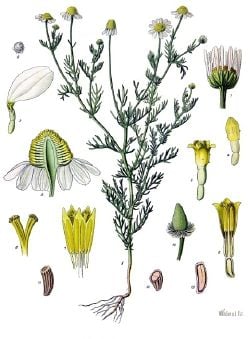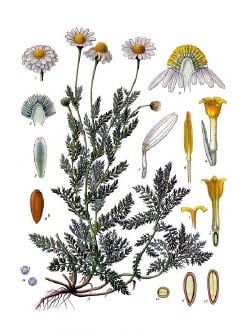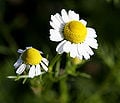Difference between revisions of "Chamomile" - New World Encyclopedia
({{Contracted}}) |
Rick Swarts (talk | contribs) (added info on roman chamomile) |
||
| Line 1: | Line 1: | ||
{{Claimed}}{{Contracted}} | {{Claimed}}{{Contracted}} | ||
| + | |||
| + | The name '''Chamomile''' or '''Camomile''' can refer to any of several distinct species in the sunflower family ([[Asteraceae]]): | ||
| + | |||
| + | * [[German Chamomile]]: ''[[Matricaria]] recutita'' (syn. ''M. chamomilla''), commonly used in chamomile [[herbal tea|tea]] | ||
| + | * Wild Chamomile or [[Pineapple weed]]: ''Matricaria matricarioides'' | ||
| + | * [[Roman Chamomile]]: ''Chamaemelum nobile'' (syn ''Anthemis nobilis'') the "lawn" chamomile. | ||
| + | * Stinking Chamomile or Dog-fennel: ''[[Anthemis cotula]]'' | ||
| + | ** and to some extent other ''[[Anthemis]]'' species | ||
| + | |||
| + | |||
| + | ==German chamomile== | ||
| + | {{Taxobox | ||
| + | | color = lightgreen | ||
| + | | name = German Chamomile | ||
| + | | image = Koeh-091.jpg | ||
| + | | image_width = 250px | ||
| + | | image_caption = German Chamomile (from [[Köhler's Medicinal Plants]], 1887) | ||
| + | | regnum = [[Plant]]ae | ||
| + | | divisio = [[Magnoliophyta]] | ||
| + | | classis = [[Magnoliopsida]] | ||
| + | | ordo = [[Asterales]] | ||
| + | | familia = [[Asteraceae]] | ||
| + | | genus = ''[[Matricaria]]'' | ||
| + | | species = '''''M. recutita''''' | ||
| + | | binomial = ''Matricaria recutita'' | ||
| + | | binomial_authority = [[Carolus Linnaeus|L.]] | ||
| + | }} | ||
| + | |||
| + | '''German Chamomile''' (''Matricaria recutita''), also spelled '''Camomile''', is an [[annual plant]] of the sunflower family [[Asteraceae]]. Synonyms are: ''Chamomilla chamomilla'', ''Chamomilla recutita'' (accepted name according to the [[Flora Europaea]]), ''Matricaria chamomilla'', and ''Matricaria suaveolens''. | ||
| + | |||
| + | It usually grows near populated areas all over [[Europe]] and temperate Asia. It is widely introduced in temperate [[North America]] and [[Australia]]. As the [[seed]]s need open [[soil]] to survive, it often grows near roads, around [[landfill]]s and in cultivated fields as a [[weed]]. | ||
| + | |||
| + | Other names include '''Wild Chamomile''', '''Hungarian Chamomile''', and '''Scented Mayweed'''. | ||
| + | |||
| + | The branched [[Plant stem|stem]] is erect and smooth and grows to a height of 15-60 cm. The long and narrow [[Leaf|leaves]] are bipinnate or tripinnate. | ||
| + | |||
| + | The [[flower]]s are borne in [[panicle|paniculate]] [[capitulum|capitula]]. The white ray florets are furnished with a [[ligule]], while the disc florets are yellow. The hollow [[receptacle]] is swollen and lacks scales. This property distinguished German Chamomile from [[Corn Chamomile]] (''Anthemis arvensis''), which has a receptacle with scales. The flowers have a strong, aromatic smell, and bloom in early to mid summer. | ||
| + | |||
| + | ===Uses=== | ||
| + | |||
| + | ====Herbalism==== | ||
| + | German Chamomile is used [[medicine|medicinally]] against sore [[stomach]], [[irritable bowel syndrome]], and as a gentle sleep aid. It can be taken as an [[herbal tea]], two teaspoons of dried [[flower]] per cup of tea. For a sore stomach, some recommend taking a cup every morning without food for two to three months. It is also used as a mouthwash against oral [[mucositis]]. It has acaricidal properties against certain [[mite]]s, such as ''Psoroptes cuniculi''. The primary active ingredient of the [[essential oil]] from German Chamomile is [[bisabolol]]. | ||
| + | |||
| + | The active ingredients are essential oils, notably [[chamazulene]], [[flavonoid]]s and [[coumarin]]. | ||
| + | |||
| + | Chamomile is also used [[Beauty|cosmetic]]ally, primarily to make a rinse for [[blonde hair]]. | ||
| + | |||
| + | ====Agriculture==== | ||
| + | Chamomile is sometimes known as "the plant doctor", because it is thought to help the growth and health of many other plants, especially ones that produce [[essential oil]]s. It is thought to increase production of those oils, making certain herbs, like mints (spearmint, sage, oregano) and basil taste stronger in scent and flavor. | ||
| + | |||
| + | Chamomile "tea" is also thought to be useful to suppress fungal growth, for example misting it over seedlings may prevent [[damping off]]. | ||
| + | |||
| + | Chamomile is frequently an invasive species in agricultural fields. Farmers often must control chamomile's spread to maintain productivity of their fields. | ||
| + | |||
| + | |||
| + | ==Roman chamomile== | ||
| + | {{Taxobox | ||
| + | | color = lightgreen | ||
| + | | name = Roman Chamomile | ||
| + | | image = Koeh-012.jpg | ||
| + | | image_width = 250px | ||
| + | | image_caption = Roman Chamomile | ||
| + | | regnum = [[Plant]]ae | ||
| + | | divisio = [[Flowering plant|Magnoliophyta]] | ||
| + | | classis = [[Magnoliopsida]] | ||
| + | | ordo = [[Asterales]] | ||
| + | | familia = [[Asteraceae]] | ||
| + | | genus = ''[[Anthemis]]'' | ||
| + | | species = '''''A. nobilis''''' | ||
| + | | binomial = ''Anthemis nobilis'' | ||
| + | | synonyms = ''Chamaemelum nobile'' | ||
| + | }} | ||
| + | |||
| + | '''''Anthemis nobilis''''', commonly known as '''Roman Camomile''', '''[[Chamomile]]''', '''garden camomile''', '''ground apple''', '''low chamomile''', or '''whig plant''', is a low [[Europe]]an [[perennial plant]] found in dry fields and around [[garden]]s and cultivated grounds. The stem is procumbent, the leaves alternate, bipinnate, finely dissected, and downy to glabrous. The solitary, terminal flowerheads, rising 8 to twelve [[inch]]es above the ground, consist of prominent yellow disk flowers and silver-white ray flowers. The flowering time is June and July, and its fragrance is sweet, crisp, fruity and herbaceous. | ||
| + | |||
| + | Chamomile is also used [[Cosmetics|cosmetically]], primarily to make a rinse for [[blonde hair]], and is popular in [[aromatherapy]], whose practitioners believe it to be a calming agent to end stress and aid in [[sleep]]. | ||
| + | |||
| + | The Chamomile is mentioned in [[Shakespeare]]'s [[Henry IV, part 1]] 'The Camomile; The more it is trodden on, the faster it grows'. | ||
| + | |||
| + | [[Mary Wesley]]'s novel ''[[The Camomile Lawn]] was also televised in [[Great Britain]] in the 1990s. | ||
| + | |||
| + | Use of Chamomile dates back as far as [[ancient Egypt]] where it was dedicated to their gods.{{Fact|date=September 2007}} Folk remedies using the plant include treatments for [[dropsy]] and [[jaundice]]. it was also believed to revive any wilting plant placed near it.{{Fact|date=September 2007}} The flowers were also used as a [[dye]] to lighten hair. | ||
| + | |||
| + | == Gallery == | ||
| + | <gallery> | ||
| + | Image:Chamomile@original size.jpg | ||
| + | Image:Matricaria recutita.jpg | ||
| + | Image:Cabbage_butterfly.jpg | ||
| + | </gallery> | ||
| + | |||
| + | |||
| + | ==References== | ||
| + | Howard, Michael. ''Traditional Folk Remedies'' (Century, 1987), p.112. | ||
| + | |||
| + | |||
| + | |||
| + | [[Category:Life sciences]] | ||
| + | {{credit|Chamomile|160180317|German_Chamomile|160678165|Roman_Chamomile|160463284}} | ||
Revision as of 21:37, 20 October 2007
The name Chamomile or Camomile can refer to any of several distinct species in the sunflower family (Asteraceae):
- German Chamomile: Matricaria recutita (syn. M. chamomilla), commonly used in chamomile tea
- Wild Chamomile or Pineapple weed: Matricaria matricarioides
- Roman Chamomile: Chamaemelum nobile (syn Anthemis nobilis) the "lawn" chamomile.
- Stinking Chamomile or Dog-fennel: Anthemis cotula
- and to some extent other Anthemis species
German chamomile
| German Chamomile | ||||||||||||||
|---|---|---|---|---|---|---|---|---|---|---|---|---|---|---|
 German Chamomile (from Köhler's Medicinal Plants, 1887)
| ||||||||||||||
| Scientific classification | ||||||||||||||
| ||||||||||||||
| Matricaria recutita L. |
German Chamomile (Matricaria recutita), also spelled Camomile, is an annual plant of the sunflower family Asteraceae. Synonyms are: Chamomilla chamomilla, Chamomilla recutita (accepted name according to the Flora Europaea), Matricaria chamomilla, and Matricaria suaveolens.
It usually grows near populated areas all over Europe and temperate Asia. It is widely introduced in temperate North America and Australia. As the seeds need open soil to survive, it often grows near roads, around landfills and in cultivated fields as a weed.
Other names include Wild Chamomile, Hungarian Chamomile, and Scented Mayweed.
The branched stem is erect and smooth and grows to a height of 15-60 cm. The long and narrow leaves are bipinnate or tripinnate.
The flowers are borne in paniculate capitula. The white ray florets are furnished with a ligule, while the disc florets are yellow. The hollow receptacle is swollen and lacks scales. This property distinguished German Chamomile from Corn Chamomile (Anthemis arvensis), which has a receptacle with scales. The flowers have a strong, aromatic smell, and bloom in early to mid summer.
Uses
Herbalism
German Chamomile is used medicinally against sore stomach, irritable bowel syndrome, and as a gentle sleep aid. It can be taken as an herbal tea, two teaspoons of dried flower per cup of tea. For a sore stomach, some recommend taking a cup every morning without food for two to three months. It is also used as a mouthwash against oral mucositis. It has acaricidal properties against certain mites, such as Psoroptes cuniculi. The primary active ingredient of the essential oil from German Chamomile is bisabolol.
The active ingredients are essential oils, notably chamazulene, flavonoids and coumarin.
Chamomile is also used cosmetically, primarily to make a rinse for blonde hair.
Agriculture
Chamomile is sometimes known as "the plant doctor", because it is thought to help the growth and health of many other plants, especially ones that produce essential oils. It is thought to increase production of those oils, making certain herbs, like mints (spearmint, sage, oregano) and basil taste stronger in scent and flavor.
Chamomile "tea" is also thought to be useful to suppress fungal growth, for example misting it over seedlings may prevent damping off.
Chamomile is frequently an invasive species in agricultural fields. Farmers often must control chamomile's spread to maintain productivity of their fields.
Roman chamomile
| Roman Chamomile | ||||||||||||||
|---|---|---|---|---|---|---|---|---|---|---|---|---|---|---|
 Roman Chamomile
| ||||||||||||||
| Scientific classification | ||||||||||||||
| ||||||||||||||
| Anthemis nobilis | ||||||||||||||
|
Chamaemelum nobile |
Anthemis nobilis, commonly known as Roman Camomile, Chamomile, garden camomile, ground apple, low chamomile, or whig plant, is a low European perennial plant found in dry fields and around gardens and cultivated grounds. The stem is procumbent, the leaves alternate, bipinnate, finely dissected, and downy to glabrous. The solitary, terminal flowerheads, rising 8 to twelve inches above the ground, consist of prominent yellow disk flowers and silver-white ray flowers. The flowering time is June and July, and its fragrance is sweet, crisp, fruity and herbaceous.
Chamomile is also used cosmetically, primarily to make a rinse for blonde hair, and is popular in aromatherapy, whose practitioners believe it to be a calming agent to end stress and aid in sleep.
The Chamomile is mentioned in Shakespeare's Henry IV, part 1 'The Camomile; The more it is trodden on, the faster it grows'.
Mary Wesley's novel The Camomile Lawn was also televised in Great Britain in the 1990s.
Use of Chamomile dates back as far as ancient Egypt where it was dedicated to their gods.[citation needed] Folk remedies using the plant include treatments for dropsy and jaundice. it was also believed to revive any wilting plant placed near it.[citation needed] The flowers were also used as a dye to lighten hair.
Gallery
- Cabbage butterfly.jpg
ReferencesISBN links support NWE through referral fees
Howard, Michael. Traditional Folk Remedies (Century, 1987), p.112.
Credits
New World Encyclopedia writers and editors rewrote and completed the Wikipedia article in accordance with New World Encyclopedia standards. This article abides by terms of the Creative Commons CC-by-sa 3.0 License (CC-by-sa), which may be used and disseminated with proper attribution. Credit is due under the terms of this license that can reference both the New World Encyclopedia contributors and the selfless volunteer contributors of the Wikimedia Foundation. To cite this article click here for a list of acceptable citing formats.The history of earlier contributions by wikipedians is accessible to researchers here:
The history of this article since it was imported to New World Encyclopedia:
Note: Some restrictions may apply to use of individual images which are separately licensed.

